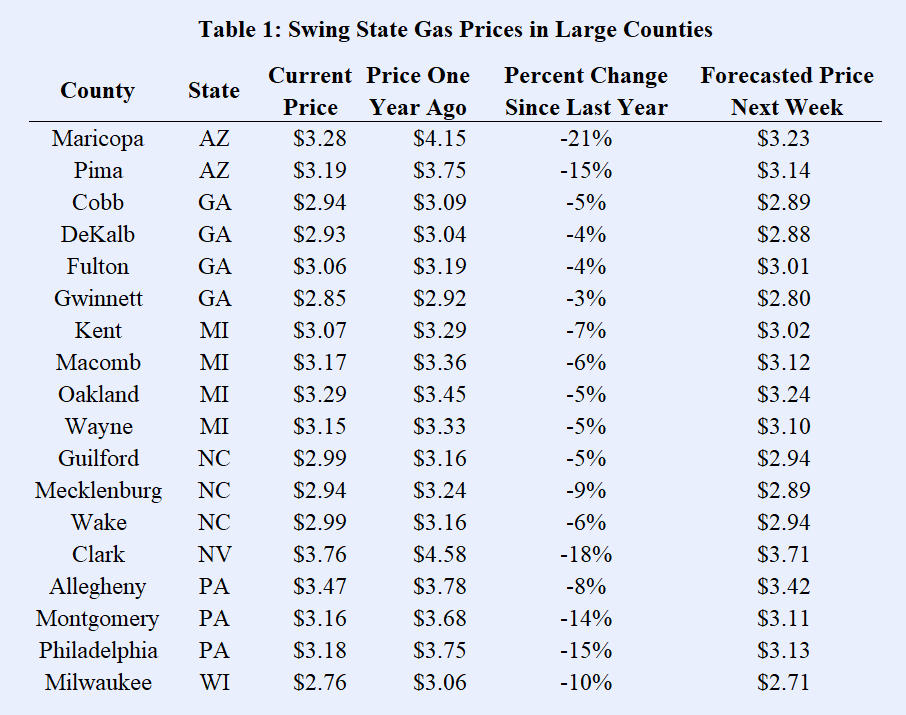Gas prices have dropped and are poised for further declines
The plunge in crude oil prices on Monday, following Israel's decision to avoid attacking Iranian energy facilities, should further reduce already low pump prices.
Crude oil prices plunged six percent (or roughly five dollars) this week after Israel avoided hitting Iranian energy facilities in retaliatory strikes on Friday night. At $3.13/gallon, the national average gas price is down 37 cents from last year. Gas prices are below $3.00/gallon in battleground states of Georgia, North Carolina, and Wisconsin and have declined by more than 50 cents from last year in Arizona and Nevada. We estimate a model of the pass-through of crude oil to retail gas prices. Based on this model, and assuming no significant market disruptions, we project that the national average gas price will drop 5 cents in the coming week and approach $3.00/gallon by the end of the month.
Gas prices have dropped and real gas prices are in the lower part of their historical range
In poll after poll, voters rank the economy and inflation as the top issues heading into the election. Gas prices, which we see multiple times per day, are perhaps the most salient indicator of the price level. Research shows that gas prices exert a disproportionate influence on consumers’ inflation expectations, their broader views of the economy, and even affect the choice of voters in Presidential elections. In a prior Briefing Book article, we showed that the media exhibits bad news bias in its gas price reporting, only covering gas prices when they are high and using a consistently negative tone. The broad importance of gas prices makes the impact of this bias potentially significant.
Currently, the national average price of regular gasoline is $3.13/gallon, down 37 cents from $3.50/gallon a year ago and $1.89 from its $5.02/gallon peak in the aftermath of Russia’s invasion of Ukraine. For the driver filling up a typical 15-gallon tank, the decline this year is saving them more than seven dollars per fill-up.
In many parts of the country, pump prices are even lower or have dropped more rapidly. Gas prices average less than $3.00/gallon in 20 states, including the battleground states of Georgia ($2.92/gal), North Carolina ($2.91/gal), and Wisconsin ($2.88/gal). Over the last year, gas prices have dropped by more than 50 cents in Arizona (77-cent decline) and Nevada (78-cent decline)
Gas prices are below $3.00 in 286 of the 513 counties in the seven battleground states, including Gwinnett, Cobb, and DeKalb County, Georgia; Wake and Mecklenburg County, North Carolina; and Milwaukee and Dane County, Wisconsin. Over the last year, gas prices have declined by more than 50 cents in Maricopa and Pima County, Arizona; Clark County, Nevada; and Montgomery and Philadelphia County, Pennsylvania (see Table 1 below).
Adjusted for inflation or wages, current gas prices are lower than they’ve been for most of the last 20 years. At $3.13/gal, the real (inflation-adjusted) gas price is lower than it has been for 78 percent of the last 2 decades.
Today, the average worker (production and nonsupervisory) needs only 6.4 minutes on the job to earn enough to buy a gallon of gas, less time than 84 percent of the last 20 years.
The plunge in crude prices should further lower prices at the pump
The price of crude oil plunged when markets opened on Monday, October 28th, following Israel’s decision to avoid attacking Iranian energy facilities Friday night. Crude prices had risen earlier this month on the possibility that Israel might target Iranian energy facilities in response to Iran’s October 1 missile attacks. When markets opened on Monday, the benchmark West Texas Intermediate (WTI) contract dropped an immediate 4.5% (see figure). As of this writing, the price is down 5.7% this week.
While changes in crude prices do not immediately translate into lower prices at the pump, the rate of pass-through follows a predictable relationship. We build a model that captures this relationship, allowing the change in retail price to depend on the current and four lags of the change in crude prices. The figure below shows the effects of a $10/barrel decline in crude oil prices in one week, followed by constant oil prices in the weeks that follow. As the figure shows, half of the decline in gas prices occurs with a lag of one week; after a month, the effect of the shock has mostly passed through to retail gas prices.
Our model fits the historical data well, producing forecasts that are generally within a cent or two of the actual value. We use the model to project future gas prices, assuming no further changes in the price of crude (as predicted by futures contracts). Based on our model, we project the national average gas price will drop 5 cents over the next week and approach $3.00/gal by the end of the month.
Assuming constant effects in each county, gas prices by next week would be below $3/gal in 1,980 out of 3,117 counties (and 331 out of 513 counties in battleground states). The table below shows the current price in battleground-state counties with populations above 500,000, along with the price change over the prior year and the forecasted price next week.












I’ve been seeing prices rise lately, but they’re still lower than $3 in Newton and Rockdale counties in GA.